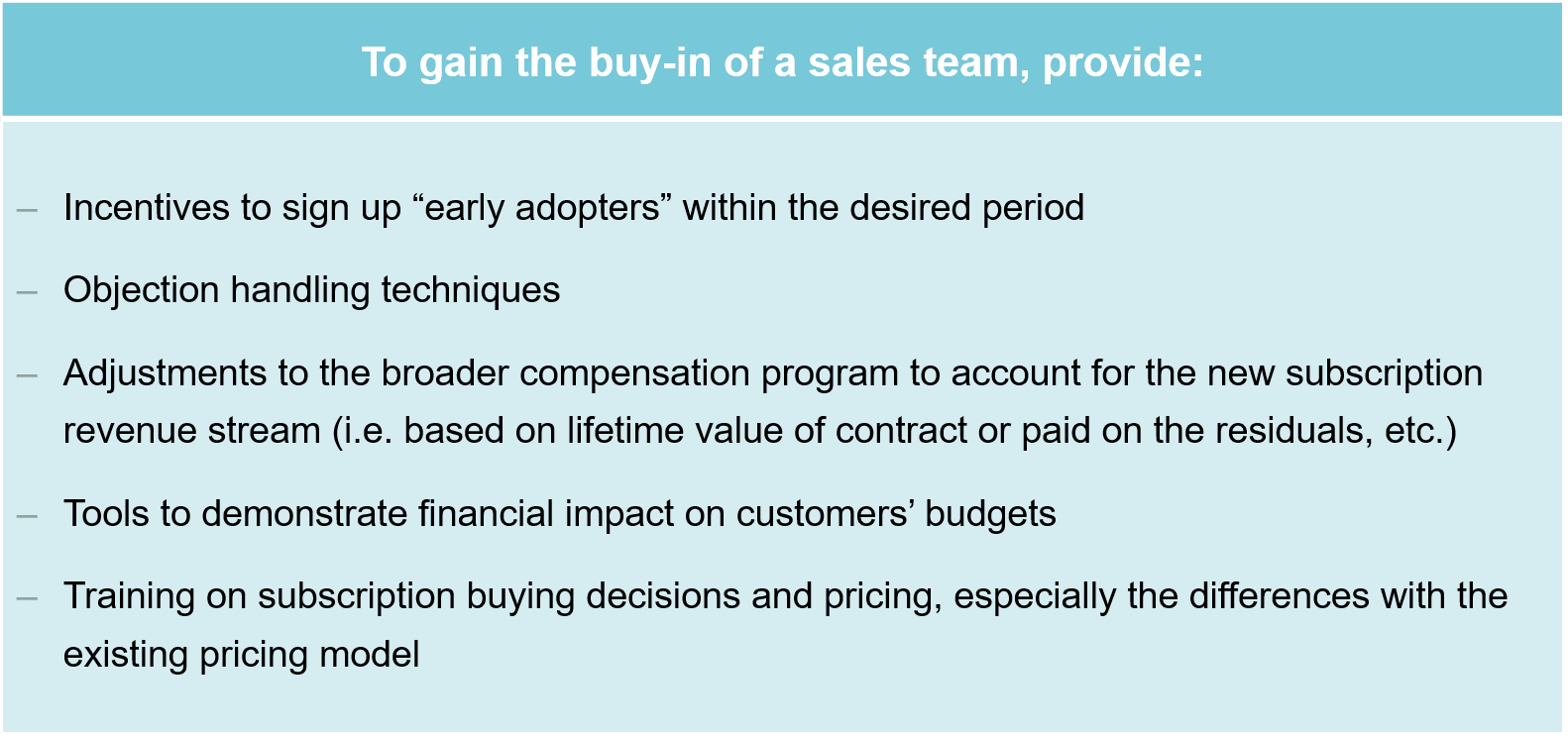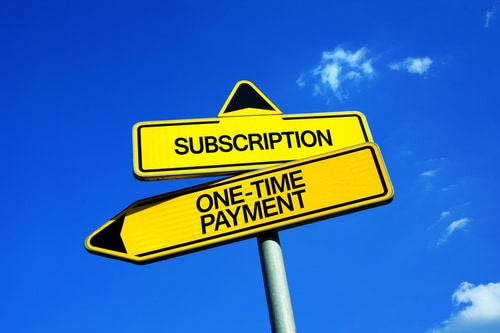By Kirk Jackisch, Global President of Pricing Solutions
We’re seeing software companies across the B2B and B2C spectrum moving towards subscription pricing as a means to drive recurring monthly revenue, cement long-term relationships with clients and accelerate firm value. In our previous article, we looked at the subscription mindset and what to take into account when determining whether you should adopt a subscription-based pricing model. In this article, we lay out how to switch from perpetual software licenses to subscription pricing. To develop an effective subscription software business plan, companies should consider the following steps:
1. Getting Customer Perspective
In order to start your move to a “value-based” subscription pricing model, take into account your customers and their needs first. How do you successfully migrate existing paid customers onto a new pricing model without harming performance? How do you incent new customers to choose the subscription option?
To answer the questions, consider the following best practices:
- Capture and analyze existing data on customers usage and billing history
- Conduct market and channel research and interview customers on value, gauging their reactions to different subscription pricing models and structures
- Design a subscription pricing solution that balances financial needs with customer needs
- Identify incentives needed to induce customers to switch to subscription pricing (e.g. pricing discounts, exclusive functionality, service upgrade, etc.)
- Conduct financial modeling to help decision makers (especially the CFO) understand the short-term and long-term financial impact
- Pilot a small test market or segment, noting customer behavior and financial results
- Make needed revisions to subscription offerings, metrics and prices accordingly
- Initiate a segmented and metric driven introduction of the subscription pricing model
- Regularly review data and adjust to meet goals
2. Gaining Internal Alignment
Not every software company will be ready to move to subscription pricing. While changing to a subscription pricing model is usually beneficial when done carefully and strategically (i.e. Adobe and Microsoft), internal and external resistance to the change is normal.
As we have worked with many companies over the last decade, we encountered these three common objections to moving away from an “outright purchase” or perpetual model, along with strategies to overcome each concern:
Objection #1: Short-Term Revenue Loss
There may be members of the management team who are unwilling to accept the up-front revenue loss (e.g. Years 1-3) that often comes with a move to subscription-based pricing, even if the organization has proven the change will result in long-term revenue growth through an increase in recurring revenue. If a company isn’t willing or able to absorb an up-front short-term revenue loss on new customers, then creative solutions will be necessary.
Solution
For a business with low take rates on maintenance and a low percentage of customers upgrading to the newest version, there is often an opportunity of targeting these customers with conversion to subscription in exchange for upgrading their features to the newest version without having to pay “back maintenance.” Typically, higher guaranteed subscription revenue more than offsets the potential maintenance loss.
The second solution is to develop an offer for a previously untapped or poorly penetrated customer segment. Typically, this will be a “low value” segment, such as small customers or a particular industry, where the current solution is “overpriced.” By targeting an under-penetrated segment, the revenues are all additive. And the business risk is eliminated.
Objection #2: Potentially Upset Customers
Some B2B companies fear that customers will be upset when asked to switch from an outright purchase and maintenance to subscription pricing, or worse, that they’ll make the move and then leave before the breakeven point* is reached.
*The breakeven point is the point where their subscription payments rise to the price of an outright purchase.
Solution
First, it’s important to realize that a company can give new and existing customers a choice between perpetual and subscription pricing models. It’s possible and in some cases even beneficial to offer new and existing customers the freedom to choose whether they’d prefer to pay under the existing perpetual pricing model or move to a subscription pricing model. In any case, most customers will appreciate having the option to choose their model.
If a company is concerned customers will discontinue business before the breakeven point is reached there are contractual options such as term requirements or “separation” fees (that are common in the cellular and leasing industries) that can mitigate potential losses. In our experience, subscription pricing is stickier than many companies fear. Most customers don’t want to go through the hassle of conducting an RFP or switching a vendor.
Finally, and perhaps most importantly, it is critical to train the sales team so that they can make customers aware of the benefits of the new subscription service. Examples of customer benefits include lower initial outlay, choice of payment options (i.e. CapEx vs OpEx), and flexibility to scale up as needs change. As well as benefits to the customer, marketing teams should develop value-based responses to potential customer questions, so customers feel confident in the move and know that their concerns have been addressed.
Objection #3: Internal Buy-In of a Marketing Team
Another key group is the marketing team, another internal force that may be resistant to the move to subscription pricing because of its unknown impact on lead generation. For marketers, introducing a new pricing offer to a customer requires amendments to nearly all aspects of a marketing strategy: from redefining the target audience to reconsidering conversion rates. To be willing to make all necessary changes to the existing marketing plan, the team will require a serious conviction.
Solution
To give the marketing department confidence in the new subscription model, it is important to educate them about the transition. To do so, marketing teams will need three key pieces of information: 1. customer segmentation strategy; 2. the value proposition of a subscription offer; and 3. marketing collateral. Make sure to explain to your marketers how subscription segmentation operates, so they can identify the target audience in each segment. To communicate the value of the subscription plan to customers, marketers also need to understand new product details, value offers, negotiation boundaries, and pain points.
Finally, to prepare the marketing department for subscription pricing, you would need to update most of the marketing team’s assets, including the website material, customer portals, solution briefs, white papers, use cases, sales presentations, and product battle cards. Factor this effort into the plan.
How to Get A Sales Team on Board?
As with many of the abovementioned objections, having a sales team “bought in” is critical to a smooth move to subscription pricing. To get the sales team prepared, first highlight the benefits of the change to the company from a financial perspective.

How customers value and use the company’s solution, and whether they want to realize the cost as capital or an operational expense, is a critical consideration when migrating to a subscription model. Also, it is important information to help set the prices of a subscription structure. Customer budgets may also be impacted depending on their policies regarding OpEx and CapEx budgeting practices, needs and approvals.
As such, a company that has already conducted market research, segmented customers, and conducted extensive interviews, will likely meet the client’s needs successfully. It’s critical that this information is shared with sales teams and the data that’s been gathered is used to create strong objection handling strategies for them to use.
Sales teams know better than anyone else in an organization that customers don’t want to pay for things they don’t need; this concept is really the crux of the adoption of subscription pricing. Ideally, clients are paying only for the products and services that they’ll use, and this principle is even more applicable to metric-based B2B buyers than consumers. Once a sales team understands this principle and sees it in action through well-thought-out pricing models, they should be enthusiastic about the switch.
Test the Waters
As with any change around pricing, it’s important to pilot with a small group and monitor results before beginning a widespread implementation. Pay attention to KPIs you may not have followed in the past, including:
- Customer behavior and usage – especially any increase or decrease in activity
- Churn and retention – the rate of customers who leave should be lower than your rate of new customers. Subscription pricing does open the door to lifetime customers (rather than a one-time sale)
The ability to capture these and other data points when testing a pricing model is critical. These two points are often strong indicators as to whether a company has hit the right price points and/or subscription offerings.
Transitioning existing customers to a subscription pricing model and noticing high customer retention rates is the highest compliment to this type of pricing strategy, but from a financial perspective, the goal is to monetize long-term relationships with clients to drive recurring monthly revenue.
When implemented effectively, subscription pricing will allow software companies to better meet customer needs and ultimately strengthen the company’s financial performance.
Read more: the case study on how our client in a mature industry successfully moved to a subscription-based model that offered a potential 18% increase in revenue per customer over 4 years.





